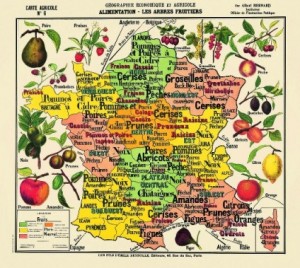Not many biodiversity hotspots escaped conflict during the past 50 years. 1 And, I’d say, not many centres of crop diversity either.
Mapping agrobiodiversity, then and now
I found this great 19th agricultural map of France at Mapping the Marvelous, a feed I’ve only recently subscribed to which is proving a real find. It was linked there to a post about city orchards at a blog called Food Mapping, a “visual exploration and mapping out of the issues surrounding local food, including the associated debates regarding economics, environmentalism, geography, sustainability and taste.” That’s also gone into the feed reader.
Nibbles: Easter Island, Quail, Kimchi, Assisted migration, Solar, Training materials, Ancient wine squared, Economics, Wild food
- People of Rapa Nui innovated as they collapsed.
- “Extinct” Bird Seen, Eaten. Sorry, National Geographic, but I can’t better that headline. Worthy of Fark.
- Kimchi madness.
- Coming to a protected are near you: moving species to save them from climate change. CWR, anyone?
- Shrinking the C footprint of traditional peanut processing. Via.
- 15 Evolutionary Gems: alas, nothing from crops, livestock. Surely domestication could have made it in there.
- “Bulgarian wine cellars have already announced that they will plant vines with the mysterious and newly recovered variety of grapes near the Orpheus tomb.”
- And more ancient wine, this time from Malta.
- Bioversity International wises up on dismal science, launches new economics webpages.
- Wild forest foods big hit at FAO booth at Lao and International Food Festival last weekend in Vientiane.
(Super)marketing agriculture
The latest ICT Update from CTA is all about market information systems in developing countries. A few months ago it was fair trade. 2 One of the featured articles is about Kenya’s commodity exchange, and the changes it has undergone since ICT Update first reported on it in 2002. This now officially qualifies as a trend. There was also news today that Ghana is thinking about following — and learning from — Ethiopia in setting up an “agricultural commodity exchange … to bring producers, buyers and consumers together to trade on a common platform by providing ready market for farm gate products from the agricultural centers.”
And far, far away, at the other end of the supply chain, Supermarket Secrets is a long (very long!) look behind the scenes at modern supermarket “practices that have significant implications on the health of our environment, our animals, our food — and ultimately our own health.” 3
LATER: Never rains but it pours. Here’s an example of such practices, from a review of the book Movable Feasts, by Sarah Murray, which sounds like a must-read: “Norwegian salmon is harvested, frozen, and sent by container ship to China, where it is de-boned in a factory, refrozen, and then sent on to markets in Europe and the US.”
Speaking of tubers …
“They’re the Ingrid Bergman to oca’s Marilyn Monroe.”
Rhizowen, the freshest new (old) voice in weird and wonderful veg is at it again with another go at Crap Crops of the Incas. This time the object of his adoration is ulluco. I wonder how they’d do on Vanuatu?

